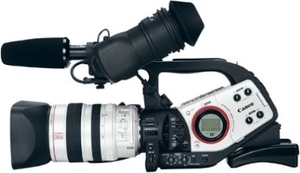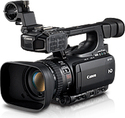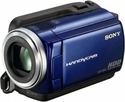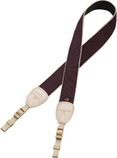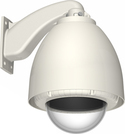The Canon XL2 allows you to capture images closer to the finished product than ever before. Work that previously was limited to post-production can be simply and effectively accomplished in the field, in the camcorder.
An Open Architecture philosophy, performance found only in much more expensive video cameras, Total Image Control and the solid foundation of Genuine Canon Optics, interchangeable lens capability and superb Canon image processing quality are united in the XL2.
The XL2 brings a host of performance and convenience features to this class of video camcorder- benefits that can't be found in this combination on other high-end video cameras. They include: Canon Super Range Optical Image Stabilization in the standard lens; dual aspect ratios; various frame rate capabilities; image gamma and detail controls; skin detail control and convertible LCD display among others.
Unprecedented image control coordination between two XL2 cameras, remote computer camera control and direct video recording to computer are just a part of the capabilities of the XL2. Never before has so much creative power been put in the hands of the film maker, video artist, and corporate and event videographer.
16:9 and 4:3 aspect ratio shooting formats
With an increasing consumer shift toward widescreen TVs that deliver the full width of film-based theatrical movies, plus the resulting need for productions in the 16:9 aspect ratio, Canon's XL2 offers both the standard 4:3 aspect ratio and the 16:9 widescreen TV aspect ratio. Whether your production is standard video, cinema, wide-screen TV, and HDTV, the XL2 -- with menu-selectable aspect ration -- is your camera.
The 4:3 aspect ratio of the traditional TV screen is the most commonly used aspect ratio in broadcasting today. The 16:9 aspect ratio is the most common aspect ratio for film-based movies, and produces full screen playback on widescreen TVs. 16:9 is also the world standard aspect ratio for HDTV.
Variable frame rates
The demands being made on the video production community to be able to provide solutions under a multitude of different scenarios have been met with the Canon XL2. It delivers 60i, 30p, and 24p frame rates (24p with 2:3 and 2:3:3:2, both with 1/48th second shutter speed).
60i (interlaced) is the standard video frame rate that has been in use for decades; it's what you see on your home TV, whether from a broadcast signal, rented DVD, or home camcorder.
30p, or 30-frame progressive, is a non-interlaced format -- the same as Canon's Frame Movie Mode -- and produces video at 30 frames per second. Progressive (non-interlaced) scanning mimics a film camera's frame-by-frame image capture and delivers spectacular clarity for high speed subjects and a cinematic-like appearance. Shooting in 30p mode offers video with no interlace artifacts.
The 24p frame rate is also a non-interlaced format, and is now widely adopted by those planning on transferring the video signal to film. But film- and video-makers turn to 24p for the "cine" look even if their productions are not going to be transferred to film, simply because of the "look" of the frame rate. As well, the shutter speed of 1/48th per second is the standard shutter speed that movie cameras use. The combination of 24p frame rate and 1/48th perfectly mimic a motion film camera.
24p with 2:3 pulldown produces video with the look and motion of film. (24p, used in conjunction with a cine gamma curve on the XL2, produces images that have similar tonal characteristics as film.) This mode is used when the finished video is to be converted to 60i so that video can be viewed on a television. 24p with 2:3:3:2 pulldown is used when the video is to be transferred to film. The 2:3:3:2 pulldown allows editing software to extract true 24 frames a second.
Customizable Cine Look
The Canon XL2 lets users fine-tune the cine look of their video recordings using a number of variables: color matrix, gamma, knee, black stretch, vertical detail, coring, sharpness, noise reduction, color gain, and hue. Each variable can be adjusted independently, thereby giving you precise control over the "film-like" appearance of your video. Because Canon utilizes a 12 bit DSP (Digital Signal Processor) customized for the XL2, maximum image quality is preserved.
Color Matrix (Video/Cine)
The XL2's Color Matrix function manages the hue and saturation of the video to reproduce the most accurate color. The color matrix defines the camera's color output; the matrix lets you define the amount of primary and secondary colors that are produced. The primary colors are red, green and blue, with the secondary colors (cyan, magenta, yellow) made from the combinations of two primary colors. With the XL2's Color Matrix, you can change from a video to a cine "look" for the end product.
Gamma (Video/Cine)
Gamma controls the general brightness (luminance) of the picture and the contrast of the picture. Adjusting gamma allows you to control the way the camera reproduces various tones. Video shot on the XL2 can be gamma corrected to allow for the final usage of the video -- where it will be shown. The display medium can distort the brightness, therefore if the gamma is corrected for the display medium when the video is shot, the display will show the correct brightness level. By switching to the Cine curve, the tonal qualities of the images produced have shading and coloration similar to that of film.
Knee (H/M/L)
Among the XL2's picture-enhancing circuits is the knee circuit. Setting the control to high, medium or low manages the highlight compression of the video signal.
Black (Stretch/Normal/Press)
The XL2 gives the user control of the depth of black in dark areas of an image. To emphasize contrast in the video's dark areas, "Stretch" is selected. To deepen or enhance the dark area, "Press" (compress) is selected.
Vertical Detail (Normal/Low)
There are 2 settings: "Normal" for vertical detail optimized for playback on an interlaced monitor, "Low" for vertical detail optimized for a progressive scan monitor like a PC.
Coring (-6 to +6)
The Coring function on the XL2 is useful in helping to remove image "noise." Coring removes fine detail information that is not a major contributor to the picture detail but which adds noise to the image. You can adjust just how much detail information is removed -- just enough coring to reduce picture noise, but not enough to hurt the detail in the image.
Sharpness (-6 to +6)
The XL2 is capable of changing the degree of sharpness in the picture. By using this feature, pictures that do not require a lot of detail can be softened. This feature also can be used to hide imperfections during close-ups, for example. Increasing video sharpness can increase the video noise slightly.
Noise Reduction (OFF/H/N/L)
Noise Reduction removes video noise -- non-picture artifacts such as those commonly found in low-light images -- without hurting image detail or creating motion artifacts. This is important for two reasons. The first is that we have become used to viewing high quality video. The second is that video noise makes compression -- to DVD, for example -- less efficient.
Color Gain (-6 to +6)
The XL2 can deliver 13 steps of color gain, from off to oversaturated. This adjustment allows you to shoot in black and white.
Color Phase (-6 to +6)
Adjust the Color Phase towards red or green for exact control.
Even Greater 3 CCD Performance
3 CCD Super Low LightBuilding on the superior image quality associated with its industry-leading XL1 and XL1S camcorders, Canon has made a major step forward with the XL2. The XL2 continues to feature a 3 CCD system with a separate progressive scan CCD (charge coupled device) for each primary color (red, green and blue), with each CCD containing 680K pixels.
With the XL2, a beam-splitting prism separates light passing through the lens into individual color components and each is sent to its own CCD. Compared to a single CCD, the three CCD system achieves outstanding detail with highly accurate color reproduction suitable for the demands of high-end video production: wide dynamic range, low color noise, high-contrast detail, natural color resolution and low-aliasing.
But the system now features even higher resolution, delivering outstanding picture quality, highly accurate color reproduction and a wide dynamic range with virtually no color noise. The three CCD image sensors are specifically designed to capture as much image detail as possible and for shooting under extremely low light conditions. In super low light, the XL2 captures crisp and clear digital data. Under extremely bright conditions, the XL2 greatly reduces vertical white streaks and smears, making it a consummate field recording device for all conditions.
-16:9: 960x480 effective pixels (460,800 pixels per CCD, total 1,382,400).
-4:3: 720x480 effective pixels (345,600 pixels per CCD, total 1,036,800).
Total Image Control
Professional videographers need to have control over the set-up of their camcorder, including complete automatic setting to fine adjustments of: Master RGB, Setup Level, Master Pedestal, Skin Tone Detail, Program AE, Gain, AE Shift and Lock, White Balance, Shutter Speeds, Aperture Control, Zebra Patterns Clear Scan and Interval Timer. Because Canon utilizes a 12 bit DSP (Digital Signal Processor) customized for the XL2, maximum image quality is preserved.
XL Mount Interchangeable Lens System
A key feature of the Canon XL-series camcorders is the XL mount interchangeable lens system. Unlike other systems, the XL2 offers users the ability to change lenses. This gives the producer/director the choice of the XL series of video lenses, third-party cine lenses, or even Canon's extensive range of photographic lenses. It also makes the XL2 the only MiniDV format camcorder with this feature.
Within the Canon XL system alone there are four lenses: the new 20x OIS, 16x OIS, 16x Manual, and 3x Wide. With an XL system adapter, the entire range of Canon photographic lenses is available -- a tremendous boon to those shooting for such productions as wildlife and nature documentaries. Other companies also offer a variety of specialty cine lenses that can be used on the XL2.
Fluorite Zoom Lens with Optical Image Stabilization
Canon has satisfied the demands of experienced image makers for years through the power, design and quality of 35mm and broadcast TV lenses. Canon continues that tradition with the new 20x Professional L-Series Fluorite optical zoom lens for the XL2. The lens uses fluorite, a material that provides outstanding resolution, contrast, and color reproduction, especially in lightweight, high-magnification lenses. The fluorite element inside the lens defeats color aberration an effect that causes a reduction in sharpness, contrast and color. It precisely controls components of light providing an excellent balance of these three critical ingredients of picture quality. The unsurpassed image quality is unobtainable with conventional optical glass.
The XL2's lens is the equivalent of a 42.3mm -- 846mm lens on a 35mm still camera, when the XL2 is recording in 16:9 widescreen format. When recording video in the TV-standard 4:3 aspect ratio, it is the equivalent of a 51.8mm -- 1036mm lens on a 35mm still camera.
In addition, the XL2 features Canon's superb Super Range Optical Image Stabilization (OIS) system (VAP type). The system corrects camera shake instantly so that even hand held shots at full telephoto and shots taken from a moving car are smooth and steady.
Previously, optical image stabilizers have used a gyro sensor to detect camcorder vibration. The data from the sensor would control a vari-angle prism that continuously corrected the path of the incoming light. Super Range goes one step further by examining the image after it is received by the CCD to detect any low-frequency vibrations missed by the gyro. This data is fed back to accelerate and refine the movement of the vari-angle prism. This greatly improves performance for low frequency vibration, resulting in the most advanced optical image stabilization available today.
And since the XL2's OIS system is optical, there isn't the loss of image quality that is inevitable with electronic image stabilizers. It perfectly complements the high picture quality of the DV format.
SMPTE time code
The Canon XL2 offers many on-camera enhancements to help capture high-quality footage, including features commonly found on broadcast camcorders. Among these is the placement of a SMPTE time code on the tape. SMPTE (Society of Motion Picture and Television Engineers) time code is a digital signal that assigns a number to every frame of video, representing hours, minutes, seconds, frames, plus some additional information. The SMPTE time code is used to identify a precise location on a video tape, a mainstay of professional editing allowing all tape and equipment to work together for precise editing.
With this feature, the XL2 conforms with industry standards and is fully integrated with today's production equipment. The camera lets you choose Drop, Non-Drop, Rec Run and Free Run modes. It also provides User bit settings which allow the inclusion of reel number or other user data.
The XL2 also generates SMPTE color bars with 1 KHz tone (-12dB and -20dB). SMPTE color bars with tone are the standard method of setting up video and audio monitors, as well as edit suites, before recording and playback, and for adjustment purposes. Using a lead-in of color bars for 10-60 seconds has become a standard in professional film and video production. The color bars also can be used during shooting to allow the adjustment of reference monitors. The XL2 can generate color bars on tape prior to shooting; this allows for fast hand-off to the professional broadcast and/or film post-production environment.
Custom Presets
Three custom presets allow you to store several camera adjustments, then retrieve them with the touch of a button for faster and easier camera operation. Among the adjustments are: color gain, color phase, sharpness, setup level, V detail, color matrix, gamma, knee, black stretch, skin detail (hue, gain, area, Y level). This feature lets you save the settings of a particular look that you've established for your video so that you can duplicate it even after another set up.
Using the IEEE1394 connection, these custom presets can be transferred to or stored on another XL2 or a computer (with the appropriate third party software). They can then be reloaded to the original XL2 when needed.
Professional Audio Connections
Canon knows that audio is crucial to professional productions -- and the XL2 provides the highest standards in audio capture available in a digital video system with a 16-bit, 2-channel recording option. The XL2 also has two additional 12-bit recording channels. This allows simultaneous recording on four channels. The XL2 permits both automatic and manual control of audio levels.
Two built-in XLR connectors with phantom power (+48V) are designed for use with professional condenser microphones. This balanced connection allows for the use of very long cables without the introduction of outside noise.
BNC connectors are used in professional and broadcast video applications. These connect a two-wire coaxial cable using a bayonet mount.
Open Architecture Design
You can customize the XL2 to fit your specific application and preferences through a full range of accessories. They include optional lenses, viewfinders, mounts and microphone adapters.
Multi-functional Color EVF with 2" LCD Monitor
Having a fully adjustable Viewfinder is critical for getting that perfect shot. The XL2 has an EVF that is convertible between a standard eyepiece and a 2" high resolution LCD. The image is shown in 4:3 or 16:9 letterbox, depending on the shooting aspect ratio. The overlay information that normally disrupts clear viewing of the subject can be completely turned off, and a center crosshair can be turned on to mark the center of the image to help with framing. Unlike other EVF systems, viewfinder brightness, color, sharpness and contrast can be adjusted to suit individual shooting taste.
For total shooting comfort, the EVF can be mechanically adjusted left to right and forwards and backwards.
-Color EVF / 2" LCD convertible.
-Right / left adjustment.
-Before / aft adjustment.
-Brightness, color, sharpness and contrast adjustments.
-EVF LCD indicators: rec/shutter/gain.
-Center cross hair (on/off).
-16:9 shown as letter box.
-EVF display (all, some, OFF -- same as XL1S).
-Body compatible with FU-100 B/W EVF (not with current color EVF).
Two Custom Keys
Two custom keys are available on the XL2, in both camera mode and VCR mode. These custom keys allow you to save your own custom settings so your common shooting modes can be readily duplicated. You select options from either the Camera Menu (Index Write, Zebra pattern, VCR stop, TV screen, Audio 1 in, Audio 2 in, Zoom grip speed, Zoom handle speed) or the VCR Menu (TV screen, Data code, Audio 1 in, Audio 2 in) and create up to two customized settings for each.
Advanced Accessory Shoe
When specific accessories compatible with the Advanced Accessory Shoe are attached, the XL2 can exchange data with them and supply power directly to them. These accessories include the VL-3 video light and DM-50 directional microphone. Also working with the Advanced Accessory Show is the MA-300 microphone adapter that lets you connect an additional two professional XLR connector microphones to the XL2. Simply slide the optional device into the accessory shoe; no external power or cables are required.
Zoom Control
-Zoom rocker (23 degrees/ one side, manual control -- 16 speeds).
-Zoom speed control behind rocker handle.
BNC/RCA/s-video terminals
With the XL2, Canon has added a BNC connector to the RCA connections and the S-video connection found on the XL1 and XL1S. The bayonet mount BNC connector is used in professional and broadcast video applications.
LANC terminal
The LANC (Local Application Control Bus System) is a remote terminal that allows you to connect the camera to LANC-compatible editing equipment.
DV Streaming
Not only can you capture high quality video with the XL2, you can stream it over the Internet. With streaming video, the content is compressed and encoded to make the file size smaller and more quickly transmitted. This lets the video be played as it is being received.
Built-in shoulder pad
To make use of the XL2 easier, there's a built-in shoulder pad. This makes extended use of the camera less physically demanding.
Dust gasket on tape door
To offer further protection to the tape, tape handling mechanism, and other internal components, the XL2 has a dust gasket on the tape door.
Wireless remote controller
The wireless controller supplied with the XL2 can operate the camera from a distance of up to 16 feet (5 m). Point it at either of the camera's remote sensors while you press the buttons. (Remote sensors are located at both the front and the back of the camera.) The tally lamps light up to indicate the camera is in range and responding to remote control commands. Other than the standard on-camera functions, there are four functions that only can be operated using the wireless controller: Special playback, Data Code on/off, Self-timer. The remote sensor on the XL2 can be turned off to prevent interference from other Canon wireless controllers being used nearby.
Software - DVPC Recorder - only available to XL Owner's Club members
Record directly to PC (XP only) -single file or individual scenes in different files. Compatible with any major editing programs -AVI-Type1 / AVI-Type2 file format.
Power Standby modes (VCR Power Same)
The XL2 has been designed to consume as little power as possible and comes with power saving features such as auto off features (activated after about 5 minutes of inactivity) to further extend battery power for field and remote work.
Technische Details
Anschlüsse und Schnittstellen
-
XL2 Feature Tour pt. 1
A detailed description of features for the Canon XL2 digital pro camcorder.
-
Canon XL2 Demo
Here is a promotion video for the awesome Canon XL2! A videowatcher also gave me another link. This vid is to big to put on YouTube so I'll just give you the...
-
Canon XL2 Mini DV Camcorder For Sale
This is a professional grade SD camcorder by Canon, it has interchangeable lenses, stereo mic, professional XLR inputs, This camera was purchased new and "ON...
-
canon XL2
canon xl2 review canon xl2 review canon xl2 battery canon xl2 used canon xl2 minidv 3ccd professional camcorder canon xl1.
-
Canon XL2 Guide : Software for the Canon XL2
Software for the Canon XL2 digital camcorder includes Canon Image Control and Storage, where the camera can be controlled remotely from the computer. Look fo...
-
Canon XL2 Guide : Canon XL2 Outdoor Filming Techniques
When filming outdoors with the Canon XL2, consider the time of day before changing the settings on the camera, as dawn and dusk require significantly differe...
-
How to Use a Canon XL2
How to Use a Canon XL2. Part of the series: Canon XL2 Guide. After purchasing a Canon XL2 digital camcorder, consult the manual, reading it cover to cover, ...
-
Canon XL2 Video Camera Military Loan Camcorder Financing
Canon XL2 video camcorder military loans finance for cameras. Credit approved regardless of bad credit history. Zero money down and low monthly payments through DoD DFAS myPay allotment ...
-
Canon XL2
This is the Standard Definition Canon Xl2 camera which I purchased in October 2005. I am retiring this for the newer Full HD and the newest 4K Ultra High Def...
-
XL2 Feature Tour pt. 3
A Continuation where part two left off. A detailed description of the Canon XL2 pro camcorder's capabilities.
-
Unboxing Canon XL2 y sus funciones
LEED ABAJO Esta videocámara es la Canon XL2, y os dejo la web oficial Web oficial: canon.es/For_Home/Product_Finder/Camcorders/professional/XL2/ Test de la C...
-
Canon XL2 Repair Loose DV Firewire Port
http://www.videoonerepair.com 888-283-2228 Canon XL2 Loose DV Firewire Port Repair Problem: We are a Canon repair service center specializing in repairing th...
-
Canon EOS Photographer Randall M. Rueff - 4 sides of the XL-1S Digital Video Camcorder
Canon EOS Photographer Randall M. Rueff - 4 sides of the XL-1S Digital Video Camcorder 2-4-2012 A.D. Randall M. Rueff P. O. Box 412 Taylorsville, Indiana 472...
-
Canon XL2 Black Rubber Roller Fell Out
http://www.videoonerepair.com. 888-283-2228 We are a service center specializing in repairing the Canon XL2 camcorder. These camcorders can have issues where...
-
Canon XL2 Sample Footage
With a factory standard 20x optical zoom lens and multiple audio ports the XL2 is a versatile machine. It can quickly go from sleepy pups, baby ladybugs on a...
-
Canon XL2 Guide : Compare the Features of a Canon XH-A1 & a Canon XL2
The main differences between the Canon XH-A1 and the Canon XL2 are the fact that the XL2 is standard definition, heavyweight and has a removable lens, while ...
-
Canon XL2 Repair, Picture Timecode Problems Audio Dropout
http://www.videoonerepair.com. 888-283-2228 We are a service center specializing in repairing the Canon XL2 camcorder. These camcorders can display a problem...
-
Canon XL2 - Review
More Information http://amzn.to/WOzTrx While the Canon XL2 3CCD MiniDV Camcorder was initially designed to be a high-end consumer product, professionals soon...
-
Canon XL2 Video Camera 3D Model
Download Canon XL2 Video Camera 3D Model at http://www.3dcb.com/56580.
